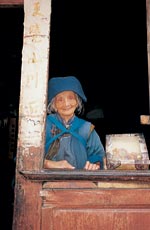
The ancient Dongba manuscript, "The Creation," is a religious text that dates back to the Tang Dynasty. Thousands of volumes survive today as an eloquent source of Naxi culture, religious beliefs, rituals and ecology.
The Naxi also developed their own religion, a blend of Lamaism, Buddhism, Taoism and Islam. The principal figure was the Dongba priest, whose task it was to perform complex rituals that worshipped nature, propitiated spirits, suppressed demons and conducted souls to the netherworld.
The Dongba's rituals, as well as ethnic music and other parts of the culture, were suppressed during the Cultural Revolution, when countless cultural and historical relics were also destroyed. Of Lijiang County's 200 famous murals painted by ethnic artists of Dongba, Tibetan Lama and Han Chinese heritage, only 55 remain.
However, since the government opened up minority areas to outsiders in 1979, Naxi traditions and culture have seen a great revival. Scholars worked with surviving Dongbas to translate pictographic manuscripts. As Lijiang became more and more accessible to foreigners in the 1980s, the outside world was stunned by the rich cultural legacy of the Naxi.
The Naxi people continue to live simply in their daily life. They celebrate the major festivals found in much of the rest of China: the Lunar New Year, the Pure Brightness Festival, the Dragon Boat Festival and the Mid-Autumn Festival, to name a few. They also have their own unique celebrations. The Farm Tool Fair in January is marked by horseracing events. In July, there is a "Mule and Horse Fair," where livestock is put on the block and the occasion is celebrated with lively song and dance.
An important Naxi festival is the Sanduo Festival, held on February 8, when the camellia flowers are in full bloom. Sanduo is the Naxi god of war or protection and the festivities to honor him are held on the grounds of a temple at the foot of the Jade Dragon Snow Mountain in Yunnan.
Legend has it that a hunter discovered an unusual snow stone in the mountains and tried to carry it home. He put the stone down for a rest and afterward, found that he could not lift the stone again. Locals later said they saw a celestial being in whiteon a white horse, wielding his spear near the stone. Naxi believed him to be a protector of their land and continue to honor him every year.
![]() 北京市通信公司提供网络带宽
北京市通信公司提供网络带宽
